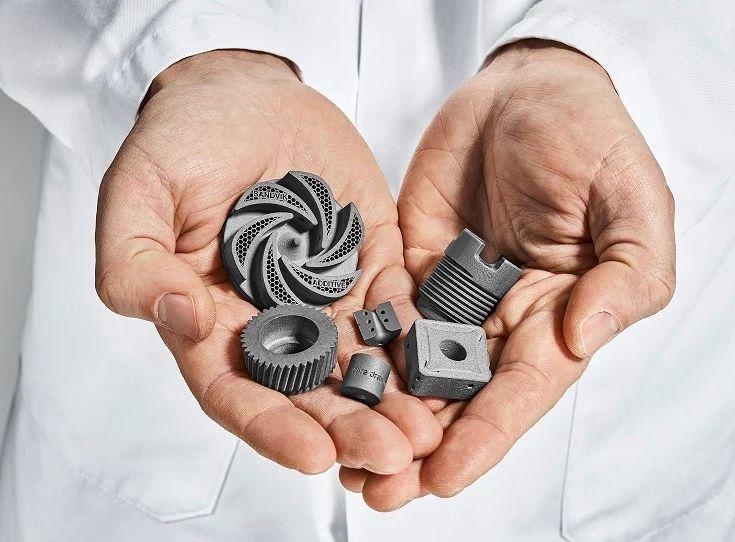China3D printingOn April 13, the Swedish multinational engineering company Sandvik announced the development of a new 3D printable cemented carbide.
Previously only used in manufacturing by other techniques, the material has a uniquely tough cobalt and tungsten carbide matrix structure that gives it the durability needed to produce parts with properties suitable for demanding applications.
Using an in-house developed process, Sandvik says it has now come up with a new cemented carbide powder that can be 3D printed faster than objects produced from other steels or alloys with a lifespan of “up to 20 times” object.
“Our powders are optimized to print components that look great, perform well, and are suitable for use in real-world applications, harsh environments and mass production,” explains Anders Ohlsson, Sandvik Additive Manufacturing Principal Product Manager. “It’s also worth mentioning that the ability to 3D print carbide has greatly accelerated our time to market. Prototyping used to take six to 12 months, and now our lead time is a matter of weeks.
Sandvik has developed unique powders and processes. “
Sandvik’s 3D printing portfolio
Sandvik’s business spans the metal cutting, digital manufacturing, mining and construction industries, but its 3D printing business typically focuses on powder development as well as consulting and manufacturing services.
In terms of materials, the company has spent over 15 years building up an extensive portfolio of Osprey 3D printing alloys. Produced in-house in one of Sandvik’s gas atomization towers, the powders can be customized to suit any printing technique, with particle sizes ranging from 5 to 500 microns. The company’s Osprey metal products range from 1kg to 6,000kg and can now be expanded from steel to nickel-based superalloys, enabling it to meet a variety of application needs.
One recent way of applying these materials is as part of GE Additive’s Binder Jet Beta Partner Program. Following a strategic partnership in late 2020, Sandvik has used its Osprey powder to supply GE Additive’s H2 Binder Jet 3D printer test system in exchange for being able to use the machine itself for production purposes.
Since acquiring a stake in BEAMIT a year ago, the company has also sought to expand the limits of its additive manufacturing capabilities. For example, Sandvik, in partnership with some of its subsidiaries, has developed the ability to 3D print super duplex stainless steel parts, and it has recently started trialing 3D printing at its mine in Boliden to improve the performance parts of drilling rigs.

Sandvik’s super duplex steel 3D printing optimized offshore impeller.Image via Sandvik
a new cemented carbide
Due to its unique composite structure, in which the wear-resistant phase is bonded together by a ductile metal binder, cemented carbide has the strength needed to produce parts for metal cutting, agriculture, food and oil and gas applications.
That being said, due to its inherent hardness, cemented carbide can be difficult to machine, especially into parts with complex geometries. Sandvik has been working with these materials since 1932, so it used its expertise to develop a way to overcome this problem, using new powder shapes with “superior wear properties”.
Developed through an undisclosed “patented process”, the powder is said to produce the same ultra-strong parts as before, while also taking advantage of the reduced waste and increased design freedom that 3D printing brings.
“When you implement additive manufacturing in your business, you essentially remove all previous design constraints—enabling you to focus on designing components according to operational needs and requirements, rather than having to adapt to a specific shape or form,” adds Ohlsson . “Carbide is by far one of the toughest, if not the toughest, materials in 3D printed shapes.”

Few parts 3D printed with Sandvik’s carbide. Image via Sandvik.
To demonstrate the potential applications of its new powder, Sandvik 3D printed it into brushed nibs as part of a recent R&D project. According to the company, the part features closed-loop helical cooling channels that allow it to cool efficiently while keeping the wire dry, something that “would not have been possible without additive manufacturing.”
China3D printingNet Comment: Looking ahead, Sandvik believes the material’s “extreme durability” will now make it well suited for the needs of “industries looking to optimize production efficiency”, especially those “operating in challenging environments” industry.Dr. Mikael Schuisky, Additive Manufacturing Business Unit Manager at Sandvik, concluded: “With our long-term experience in materials technology and our expertise in the additive value chain, we are able to innovate at a speed that no one else can match. Putting us in a unique position to drive the industrial transformation of 3D printing and demonstrate that sustainable manufacturing is not only possible – it is already happening.”
Sandvik’s 3D printed carbide brushed nib. Image via Sandvik.
Advances in High Strength Materials
While Sandvik’s cemented carbide breakthrough is undoubtedly impressive, it is far from the first company to start investigating the material’s 3D printing potential. In fact, back in 2019, VBN Components won the MM Maschinenmarkt’s Innovation Award for Additive Manufacturing for its cemented carbide Vibenite 480 material.
Elsewhere, many other “super alloys” have been developed, especially considering the additive manufacturing of high-strength components. Early last year, researchers at the University of California, Santa Barbara and Oak Ridge National Laboratory revealed that they had come up with a new defect-resistant 3D-printed superalloy capable of overcoming cracking problems that often occur in high-temperature PBF-produced parts.
Likewise, Rosswag Engineering recently qualified its nickel-based Waspaloy, which it says has excellent corrosion and oxidation resistance. In the company’s initial tests, Waspaloy had a tensile strength of 1403 MPa and an elongation at break of 21 percent, giving it superior performance over metals such as Inconel 718, which are often used to meet demanding aerospace applications.
China 3D Printing NetworkCompile the article!
(responsible editor: admin)


0 Comments for “Sandvik Introduces New Carbide for 3D Printable Durable Parts”